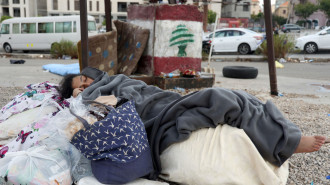
Jordan under acute water stress as global warming, the refugee crisis and mismanagement take their toll

Jordanian farmer Ali Brizat lost his vegetable crop in Wadi Al Hidan, Madaba province last year after the water supply was cut off when the Wala Dam dried up in September 2021: "I sowed, but never reaped – all my effort was wasted," is how he puts it. Aside from his vegetable crop, his lemon, guava and olive groves were also badly damaged by the drought.
He planted them ten years ago, he says, stressing that September and October are crucial months for those trees, during which they need plenty of water to maximise how much healthy fruit they produce. Ali's farm wasn’t the only one affected by the Wala dam drying up.
The Ministry of Agriculture sent a committee to document the damages. It listed 109 farmers as having suffered damaged crops over an area of 2,670 dunums.
Farmers along the entire length of Wadi Al Hidan had warned of a disaster during August and early September in light of the dam's dropping water level: they all used wells fed by the dam.
"Farmers along the entire length of Wadi Al Hidan had warned of a disaster during August and early September in light of the dam's dropping water level: they all used wells fed by the dam"
Adnan Khadam, head of the Jordan Valley Farmers' Union stated that the situation of the Wadi Al Hidan farms was just one part of the crisis Jordan had suffered between last September and November: "Six out of 17 dams dried up, the most important of which were Wala, Mujib and Tannur, due to the delay in rainfall and the rise in temperature."
Neglect exacerbates water losses
A former official in Jordan's water sector (who preferred to remain anonymous) said that repeated neglect and mis-administration were to blame for the Wala, Mujib and Tannur dams drying up in late 2021, and the resulting death of millions of fish, as well as the damage to the farms.
He says the Wala and Mujib dams were both drained of four million cubic metres (mcm) of water in anticipation of the autumn rains which were then not only late but were less than average.
This process is usually done so that dams won't be filled beyond their capacity, however, in this case, a huge volume of water was lost and wasn't replenished, according to the official.
|
|
Water levels dropping due to climate change
Jordan is among 17 countries that suffer from "extremely high" levels of water stress, according to the World Resources Institute. Thirst has become a looming threat, and the World Bank estimates economic losses from climate-related water scarcity in Jordan at 6-14 percent of GDP by 2050.
Jordan is the second poorest country worldwide in terms of drinking water sources, according to Omar Salameh, spokesman for the Ministry of Water and Irrigation. He says climate change has exacerbated the situation by depleting the country's natural water sources, which are divided into traditional and non-traditional sources. Traditional sources include surface waters like the King Abdullah Canal, Yarmouk River, Zara and Ma'in hot springs, groundwater aquifers like al-Dissi and the dam waters.
Non-traditional sources include desalinated groundwater, which can be used for agriculture and as drinking water, as well as treated wastewater from sewage plants, used for irrigating forest trees, and non-edible plants and growing animal fodder.
"Jordan is the second poorest country worldwide in terms of drinking water sources"
A study by the Germany-based Federal Institute for Geosciences and Natural Resources and the Jordanian Ministry of Water and Irrigation published in 2019 highlighted the impact climate change was having on the rate of spring discharge (water which leaves groundwater basins in the form of springs) – which had declined to under 50 percent of what it was before 1970. Water levels in the groundwater basins themselves had also dropped by around 8 metres per year due to excessive pumping, declining rainfall, and increased evaporation rates.
Jordan among countries most affected by climate change
The Middle East is one of the regions most affected by global warming and is characterised by fragile ecosystems, on which the impact of climate change is clear, says Dr Muheeb Awawdeh, lecturer in the department of Earth and Environmental Sciences at Yarmouk University.
Climate change is having negative impacts across the world, a result of damage to the atmosphere due to CO2 emissions from combustion processes, resulting in a warming planet. One impact of this is increased evaporation of rainfall.
In Jordan and other arid climates, the volume of rainfall lost through evaporation is estimated at 90 percent, with the remainder filtering into the soil. Once that is saturated, it penetrates deeper to replenish groundwater basins, or transforms into surface runoff such as torrents, which can run into valleys and surface water bodies like dams, helping to replenish them.
Over the past years, increased evaporation rates have caused more frequent droughts, delayed rainfall, reduced rainfall, and increased desertification, according to Dr Mohammad Al Farajat, professor of Geology and Environment at Al-Hussein Bin Talal University. This has also reduced soil quality, and lessened groundwater replenishment, as well as decreased vegetation cover and Jordan's natural biodiversity, he says.
Drinking water shortages
Groundwater is Jordan's primary water source for all purposes. Reduced levels pose obvious threats to drinking water supplies and agriculture, which threatens the kingdom's food security, says Dr Al Farajat, who also mentions that as water levels decline salinity increases – which can also endanger crops when used for irrigation.
Last year Jordan recorded a deficit in drinking water of around 50 mcm. The country's annual needs for all purposes are between 1.2 and 1.3 billion cubic metres (bcm), according to Salameh, however, only 900 mcm was available. The annual deficit in water supply for farming, commerce, tourism and other areas is estimated at between 400 mcm and 500 mcm.
Six of Jordan's 17 dams have dried up.
— The New Arab (@The_NewArab) November 11, 2021
Another, King Talal dam, is just two weeks away from the same fate.
This is one way the climate crisis is affecting the country:https://t.co/RMViNehExc
Because of the shortages, water is only pumped to certain areas once a week, and in some places only once every 20 days, says Salameh. The share of water per person per year is 80 cubic metres, which is well below the global water poverty line of 500 cubic metres. This has a drastic impact on the lives of Jordanians.
Raghda Faqir lives in Zarqa, east of Amman. She says: "We call the water tankers to come and fill up the house water tanks once a week, which adds extra pressure on the family, as it costs 150 dinars (around US$212) every month, but we have to because of the lack of water reaching our neighbourhood."
Leaky pipes waste precious resource
Jordan's problems have been worsened by the Syrian refugee crisis, which added huge pressure to already scarce resources, says Salameh. There is also a large amount of leakage because of a decrepit water pipe network; Aqaba city lost up to 37 percent of its water supply due to leaking pipes, and in Amman, Zarqa and Madaba, losses are estimated at 46 percent, he says, adding that the water and irrigation ministry was working to improve these networks to reduce the amount of leakage.
"Jordan lacks a systematic plan for prevention when it comes to the water crisis"
He adds that the ministry is also working on projects to secure alternative water sources, for instance, desalinated water from the Red Sea, which will increase water supplies. The ministry hopes that continuous pumping will be possible in the next five years, and a water carrier project is also underway. However, he complains about the lack of funds allocated to projects like the al-Dissi desalination project, which has stalled due to insufficient funding: "The ministry has been trying to implement strategic projects to confront water shortages for years, but lack of funding is preventing it."
Lack of strategic planning
Dr Elias Salameh, former professor of Hydrology and Hydrochemistry at the University of Jordan, criticises the absence of a clear strategy to confront climate change and water scarcity. He says relevant parties were warned early on and solutions were put forward, but they were short-term, like increasing groundwater pumping.
The environment ministry spokesman, Ahmad Obeidat, says Jordan's National Climate Change Policy has been updated and submitted to the Jordanian cabinet for approval. The policy covers the period from 2022-2050. It aims for Jordan to achieve a zero-carbon economy over the next two decades and to implement adaptations to increase resilience in all sectors to the impacts of climate change. It proposes investment in green technologies and initiatives and achieving sustainable development goals at a national level. The policy also calls for investment in environmental education and scientific research.
Mohamed Omar Shaheen, president of the Fish Farming and Animal Husbandry Association, agrees that at present Jordan lacks a systematic plan for prevention when it comes to the water crisis.
Instead, the water ministry has simply reacted to repeated crises in a way which is short-term and unsustainable – for example, paying one million dinars in compensation to farmers affected by the Wala dam drying up, he says. If a long-term strategy had been followed, "the issue would not have happened, and this money could have been invested to support farmers in other ways, like smart agriculture," he says.
This is an edited translation from our Arabic edition. To read the original article click here.
Translated by Rose Chacko
This article is taken from our Arabic sister publication, Al-Araby Al Jadeed and mirrors the source's original editorial guidelines and reporting policies. Any requests for correction or comment will be forwarded to the original authors and editors.
Have questions or comments? Email us at: info@alaraby.co.uk





 Follow the Middle East's top stories in English at The New Arab on Google News
Follow the Middle East's top stories in English at The New Arab on Google News


